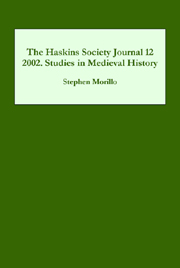Book contents
- Frontmatter
- Contents
- Editorial Note
- Abbreviations
- 1 Religious Houses and the Laity in Eleventh- to Thirteenth-Century England: An Overview
- 2 Two Yorkshire Historians Compared: Roger of Howden and William of Newburgh
- 3 The Rise and Fall of the Anglo-Saxon Law of the Highway
- 4 Consilium et Auxilium and the Lament for Æschere: A Lordship Formula in Beowulf
- 5 Royal Succession and the Growth of Political Stability in Ninth-Century Wessex
- 6 From Anglorum basileus to Norman Saint: The Transformation of Edward the Confessor
- 7 St þorlákr of Iceland: The Emergence of a Cult
- 8 Reshaping the Past on the Early Norman Frontier: The Vita Vigoris
- 9 The Appeal to Original Status in the Angevin Region (Eleventh–Twelfth Centuries)
- 10 Dudo of St. Quentin as an Historian of Military Organization
4 - Consilium et Auxilium and the Lament for Æschere: A Lordship Formula in Beowulf
Published online by Cambridge University Press: 12 September 2012
- Frontmatter
- Contents
- Editorial Note
- Abbreviations
- 1 Religious Houses and the Laity in Eleventh- to Thirteenth-Century England: An Overview
- 2 Two Yorkshire Historians Compared: Roger of Howden and William of Newburgh
- 3 The Rise and Fall of the Anglo-Saxon Law of the Highway
- 4 Consilium et Auxilium and the Lament for Æschere: A Lordship Formula in Beowulf
- 5 Royal Succession and the Growth of Political Stability in Ninth-Century Wessex
- 6 From Anglorum basileus to Norman Saint: The Transformation of Edward the Confessor
- 7 St þorlákr of Iceland: The Emergence of a Cult
- 8 Reshaping the Past on the Early Norman Frontier: The Vita Vigoris
- 9 The Appeal to Original Status in the Angevin Region (Eleventh–Twelfth Centuries)
- 10 Dudo of St. Quentin as an Historian of Military Organization
Summary
Æschere is lamented at considerable length and in some detail in Beowulf, and since he is a character who never speaks and whose sole function is to die and eventually lose his head, one might wonder why an apparently peripheral character merits such extended attention. If his actual role in the narrative of the poem is marginal, the lament for Æschere is carefully structured, and, as I hope to show, ideologically significant. Æschere, for those readers who might need to be reminded, is the sole victim of Grendel's mother's raid on Heorot, a raid undertaken to revenge the death of Grendel at the hands of Beowulf. Since Grendel's mother, unlike her son, is not invulnerable to weapons, she is actually in considerable danger during her raid on Heorot, and only has time to slay one warrior before retreating to the mere. Unfortunately the warrior she slew was a particular favorite of Hroðgar's – one whom Hroðgar and the other Danes will miss bitterly.
Heo wæs on ofste, wolde ut þanon,
feore beorgan þa heo onfunden wæs;
hraðe heo æþelinga anne hæfde
fÆste befangen, þa heo to fenne gang.
Se wæs Hroþgare hæleþa leofost
on gesiðes had be sæm tweonum,
rice randwiga, þone ðe heo on ræste abreat
blædfæstne beorn. (1292–9)
She was in haste – she wished to go out from there
To save her life when she was discovered.
Quickly she seized one of the nobles
When she went to the fen.
He was the dearest of men to Hroðgar
In the rank of retainer between the seas
A mighty shield fighter whom she destroyed in his sleep
A famed warrior.
- Type
- Chapter
- Information
- The Haskins Society Journal 122002 - Studies in Medieval History, pp. 71 - 82Publisher: Boydell & BrewerPrint publication year: 2003

